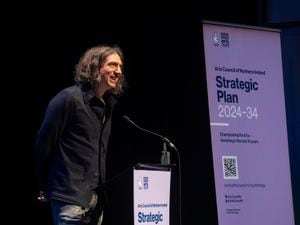Lightbody says arts must not be neglected as he launches new strategy
The Arts Council of Northern Ireland said its strategy calling for further investment in the sector been informed by extensive consultation.

Snow Patrol’s Gary Lightbody has said the arts are “essential for the survival of the soul” as he backed a new 10-year strategic vision to develop a more financially stable sector in Northern Ireland.
The Arts Council of Northern Ireland said its strategy calling for further investment in the sector had been informed by extensive consultation with the public, across the arts community, and government.
Launching the strategy in Belfast, Mr Lightbody spoke of imagining a world without the arts.
He said: “The feeling I get sometimes when I speak to politicians is that art is a luxury, art is extra, a societal appendage, something frivolous.
“No-one’s ever said to me in so many words, but the intimation is that art is something we will have time and money for once we fix everything else.”

He added: “Picture the best life for yourself and now from that great canvas of your best imaginable life that you’ve painted in your mind, take away music, take away poetry and prose, remove dance and dancing, and theatre and film, get rid of all the great towering works of art carved into sculpture or canvas, erase all the arts from that picture of your perfect life; how close to perfect is it now?
“So while I agree that art is not essential for survival, it is essential for the survival of the soul.
“Our best days are made better with music, our worst days are made better with music.
“To do right by our people, their mental health, their hearts, their souls, art is not something society can afford to neglect.”
Explaining the new strategy, Arts Council chair Liam Hannaway said: “We have consulted more widely than ever before, and listened carefully to feedback over the last eight months.
“The Arts Council’s strategic plan for 2024-2034 is an ambitious – but realistic – long-term road-map.
“It charts six outcomes and 10 priorities that will help us achieve our vision – a vision of a society where all people can experience a thriving arts sector that is recognised as essential to creativity, well-being, and social and economic prosperity.
“We need to ensure we have an arts sector that is valued publicly by leaders and decision-makers across Northern Ireland and internationally.
“The Arts Council will use our expertise to support the thousands of artists and arts organisations across Northern Ireland, to invest, advocate and evidence the positive impacts of the arts sector, socially, culturally and economically.”
Roisin McDonough, chief executive of the Arts Council, said: “This strategy outlines our mission to develop and champion the arts in Northern Ireland through investment and advocacy.
“It states our commitment to supporting artists, promoting inclusivity and diversity, fostering collaboration, and ensuring that the arts are accessible to all.
“If we are to fulfil our strategic ambitions and establish a more financially stable arts sector, we do need to find additional investment – we hope the minister will listen, and help open doors across government to allow the arts to contribute to the delivery of wider programme for government outcomes, as many of our artists do already in the areas of health, cultural tourism and the economy.
“Our artists contribute so much to society in return for a comparatively small amount of exchequer funding, think how much more we can do over the next 10-years with more strategic support?
“Over the coming decade, with the Arts Council’s strategic plan 2024-34, we can build a brighter, more vibrant, and more culturally rich Northern Ireland.”
To develop the strategy, consultation was undertaken with 162 responses received via an online survey, and a further nine standalone written submissions were received on behalf of organisations, arts organisations, public bodies, private sector, and the public.
Three quarters of responses came from three categories: artists (30%); arts and arts resource organisation (28%); and members of the public currently engaged in the arts (20%).





